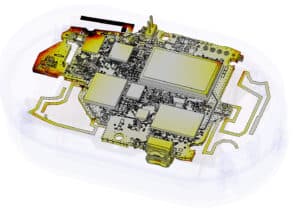ExcellAnt antenna design service
ExcellAnt design service focuses on demanding electromagnetic and antenna system design. We offer antenna research services, feasibility studies, proof-of-concept studies, and antenna design depending on your needs.
Excellant ISO 9001 qualified design process is combination of the strong understanding of electromagnetic theory and the efficient use of latest 3D electromagnetic design tools. This enables shorter time to market, lower costs and lower risks of your wireless product design.
Expertise
Decades of antenna design experience for various wireless products for industrial customers.
Several patented antenna solutions.
A burning desire to participate in challenging design tasks.
ExcellAnt’s antenna professionals are a small group of highly talented PhDs who have proven their abilities in the service of global telecommunication giants and academic world. They can quickly design and optimize your antenna solution by efficient 3D electromagnetic design tools. From small IoT devices to large antenna systems.
The design work is based on efficient GPU computing solutions that enable also detailed simulations of electrically large antennas and their environment.
Examples of antenna solutions
- Millimeter wave radar antennas
- Antenna arrays
- Integrated lens antennas
- RFIC lens antennas
- Integrated Mobile & IoT antennas
- Phase-accurate antennas
- Antenna feeding networks
- Passive repeaters
- Resonators
- Phase correction lens for horn antennas
- Custom antennas
Examples of radio technologies
- MmWave radars
- Cellular 4G / 5G
- NBIoT / LTE-M
- GPS / GNSS
- WiFi & Bluetooth
- NFC
- LoRa
- Any customer specific radio solutions (ISM 2.45 GHz & 5.8 GHz)
As a natural continuation of the design services, ExcellAnt offers the construction of the first antenna prototypes as well as impedance and radiated antenna measurements.
Phase-accurate antennas
October 16th 2023
In recent years, special attention has started to be paid to other radiation properties of the antenna, than the gain and amplitude radiation pattern. In certain applications, incl. accurate distance measurement or accurate GNSS positioning using radio waves requires good phase performance from the antenna.
In practice, a phase-accurate antenna means that the antenna sends and receives electromagnetic waves in the same phase from different directions. The performance of positioning antennas is described by Phase Center Variation (PCV), which tells how much the antenna’s phase center changes when viewing the antenna from different directions. The smaller is the variation, the more accurate positioning can be achieved. A phase-accurate GNSS antennas can have PCV of few millimeters.
A phase-accurate antenna is usually very challenging to design. It is particularly difficult to design a phase-accurate antenna for predetermined mechanics, which have a large effect on the antenna. ExcellAnt has found a highly efficient solution for designing phase-accurate antennas and can apply its know-how to your phase-accurate antenna challenge as well.
Some thoughts on NB-IoT antenna design

The antenna design process begins with a review of the product requirements. In general, requirements are precise in terms of frequency bands with the aim to minimize regional product variants. Depending on the use case of the IoT device, different frequency bands are required for the device. Low-frequency bands (e.g. B5, B8, B13) are commonly used to increase the range of the device and require a slightly larger antenna structure, while higher-frequency bands (e.g. B1, B2) have more bandwidth and the antenna is also smaller. This leads to a multi-band antenna solution, where the main goal is a good impedance matching of the antenna and the highest possible overall efficiency.
Typically, IoT devices are very small in size and this creates greater challenges for antenna design. Most of the commercial off-the-shelf (COTS) antenna components are useless because they do not fit inside the device. There are also very small ceramic antenna components on the market, which would fit the device due to their size. In order to work with good efficiency, they usually require a large ground level, which the devices do not have. In addition, the target market price of IoT devices is low, so the antenna solution must be very cost-effective. Because of these, the antenna is typically implemented either on the circuit board of the device or on a conductive structure in the housing.
The small size of IoT devices limits the antenna performance. In the case of a resonance type antenna, the volume, achievable bandwidth and efficiency of the antenna are interdependent. (Volume must be understood as the volume of the device in general, because a large part of the radiation of the device originates from the entire device.) If the volume of the device is reduced, the bandwidth and/or efficiency of the antenna will decrease. In general, the aim is to maximize the bandwidth so that it covers the targeted bands. In this case, the efficiency decreases. However, the antenna bandwidth can be increased by using several resonances and even more resonances can be created with the help of a matching circuit.
How to maximize the antenna efficiency of your small multiband IoT device, which is very important for the device’s range and battery life?
ExcellAnt’s antenna professionals are specialized in solving these tricky challenges. When you really need a good and cost-effective antenna for your product, please contact us. We have the expertise.
More information
Mikko Vuolteenaho
CEO
mikko.vuolteenaho@excellant.fi
Tel. +358 40 510 9000